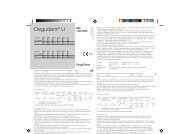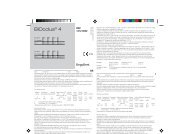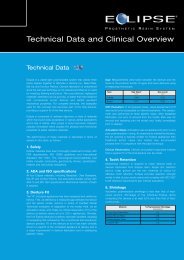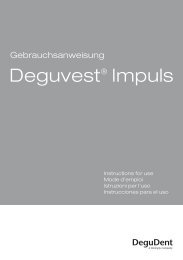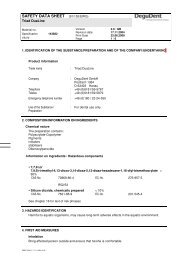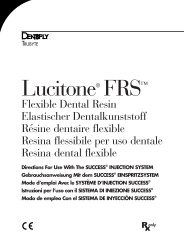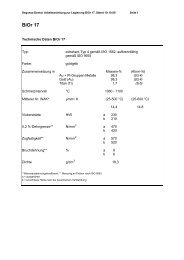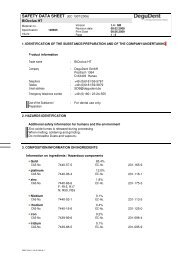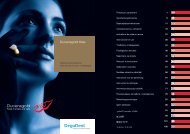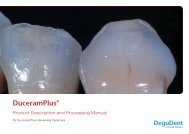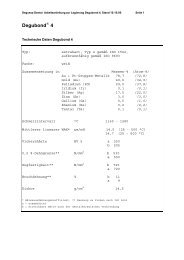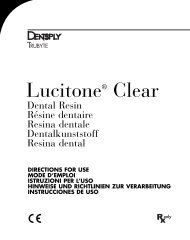Create successful ePaper yourself
Turn your PDF publications into a flip-book with our unique Google optimized e-Paper software.
Instructions for use<br />
a b c General ceramic repairs and corrections<br />
Abrade the metal framework carefully with aluminium<br />
oxide 110–150 μm. Then clean the bridge with care.<br />
LFC Opaquer should never be mixed with opaquer<br />
fluid but only with Modelling Liquid. The exposed metal<br />
parts are coated with LFC Opaquer. Fire in accordance<br />
with the LFC wash firing directions (Fig. 1).<br />
Next, layer with LFC materials (Fig. 2).<br />
LFC materials can be applied directly to the smooth<br />
surface and fired without prior surface treatment.<br />
Lightly smooth and polish the transition zones with<br />
a rubber polisher and diamond paste.<br />
A bridge repaired with LFC after the firing procedure<br />
(Fig. 3).<br />
d e f Corrections and surface finishing of<br />
ceramic shoulders<br />
Enhanced precision of fit can be obtained also<br />
through post-glazing application of LFC or SM-L<br />
materials. All shade corrections should be completed<br />
before using these materials. Use only SEP<br />
Isolating Liquid to separate the die. The die must<br />
not be sealed; this reduces ease of separation.<br />
LFC materials selected according to the LFC indicator<br />
are dabbed with the specified liquids and applied<br />
to the shoulder in need of correction (Fig. 4).<br />
The workpiece is mounted on the master cast using<br />
gentle tapping and concomitant suctioning. Once<br />
the LFC material is well dried, the workpiece is removed<br />
carefully from the cast and fired according<br />
to the directions for firing (Fig. 5).<br />
The transition zone between the LFC and the metalveneer<br />
ceramic should be finished with a rubber<br />
polisher and then smoothed and polished with diamond<br />
paste.<br />
Finished crown (Fig. 6).<br />
26<br />
g h i j k l m n o p<br />
Ceramic inlays, onlays, facets<br />
To fabricate inlays, onlays and facets, model systems<br />
are available that use state-of-the-art methods to<br />
enable FFM dies to be mounted on the master cast.<br />
Using LFC materials, however, a method has been<br />
developed that permits one to skip the use of such<br />
specialized model fabrication systems. One can<br />
fabricate ceramic inlays and facets by a simple<br />
method which is both intuitive and economical.<br />
Because of their brilliant light diffusion and extremely<br />
homogeneous surfaces, LFC materials are setting the<br />
standard in aesthetics, occlusal repairs, and periodontic<br />
acceptability.<br />
Once the duplication model has been fabricated with<br />
Ducera ® Lay Superfit die material, a ceramic veneer<br />
of Duceram ® Kiss is fired on the die, and this is then<br />
transferred to the master cast. When using LFCs, layer<br />
the workpiece to the desired form and shade, remove<br />
it from the master cast, and fire it on furnace<br />
wadding.<br />
Based on the wide differences in firing patterns between<br />
Duceram ® Plus or Duceram ® Kiss and LFC, the<br />
close fit of the ceramic veneer is not affected at all,<br />
even with geometrically awkward inlays.<br />
The work sequence in detail:<br />
Prepare the master die.<br />
Develop an appropriate cementation gap on the master<br />
die with Ducera ® Lay Spacer. The spacer should come<br />
no closer than approx. 1 mm to the preparation margin.<br />
Block out any undercuts (Fig. 7).



